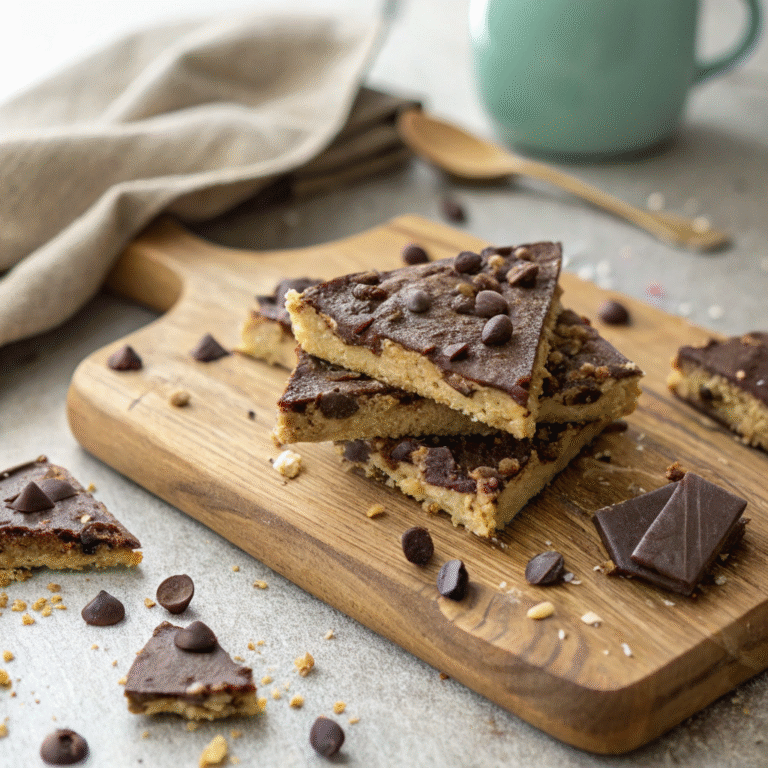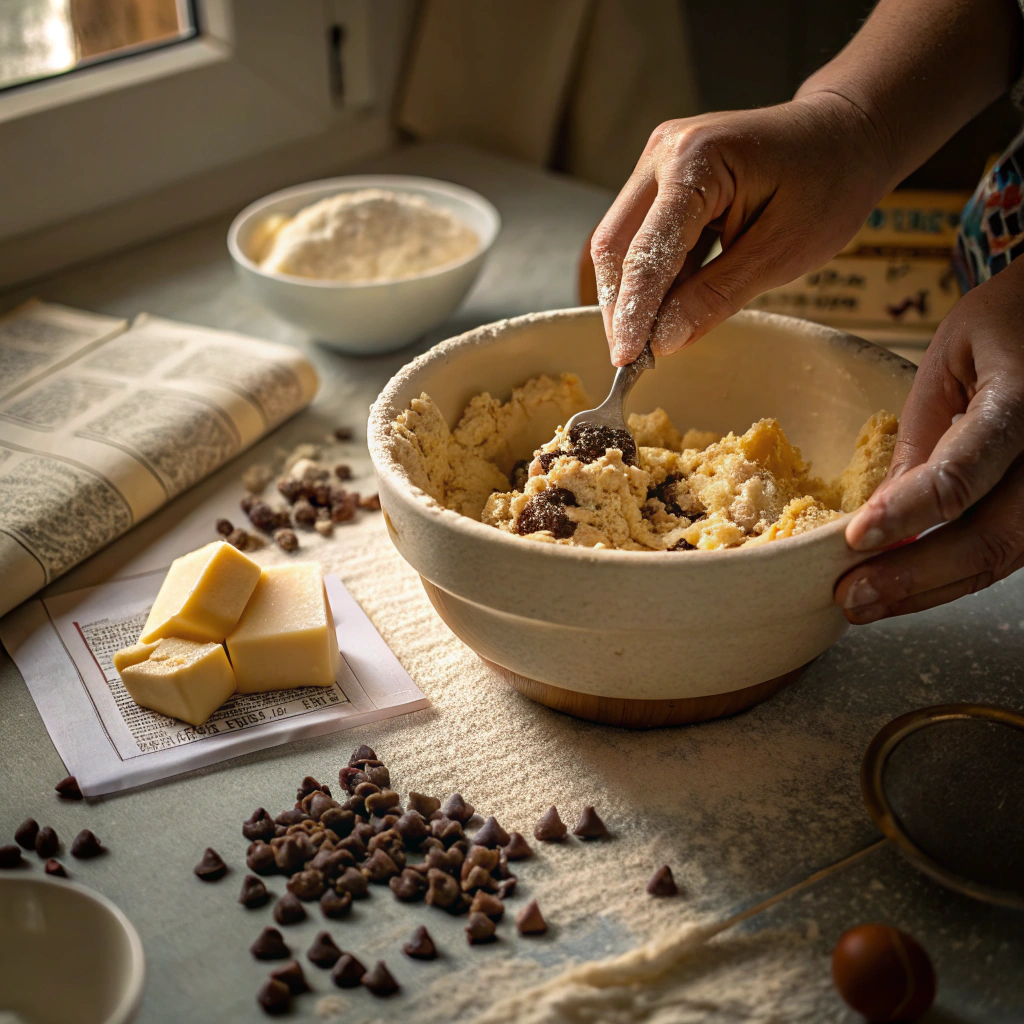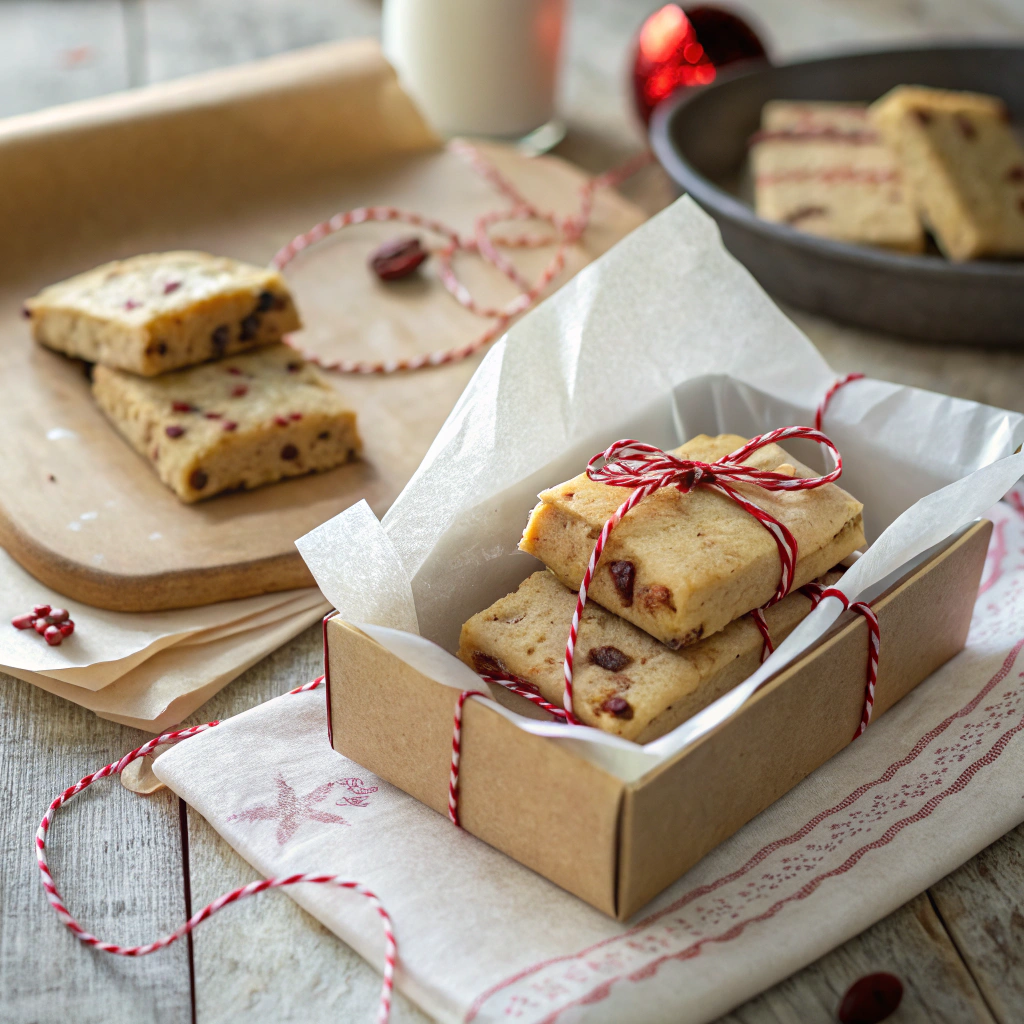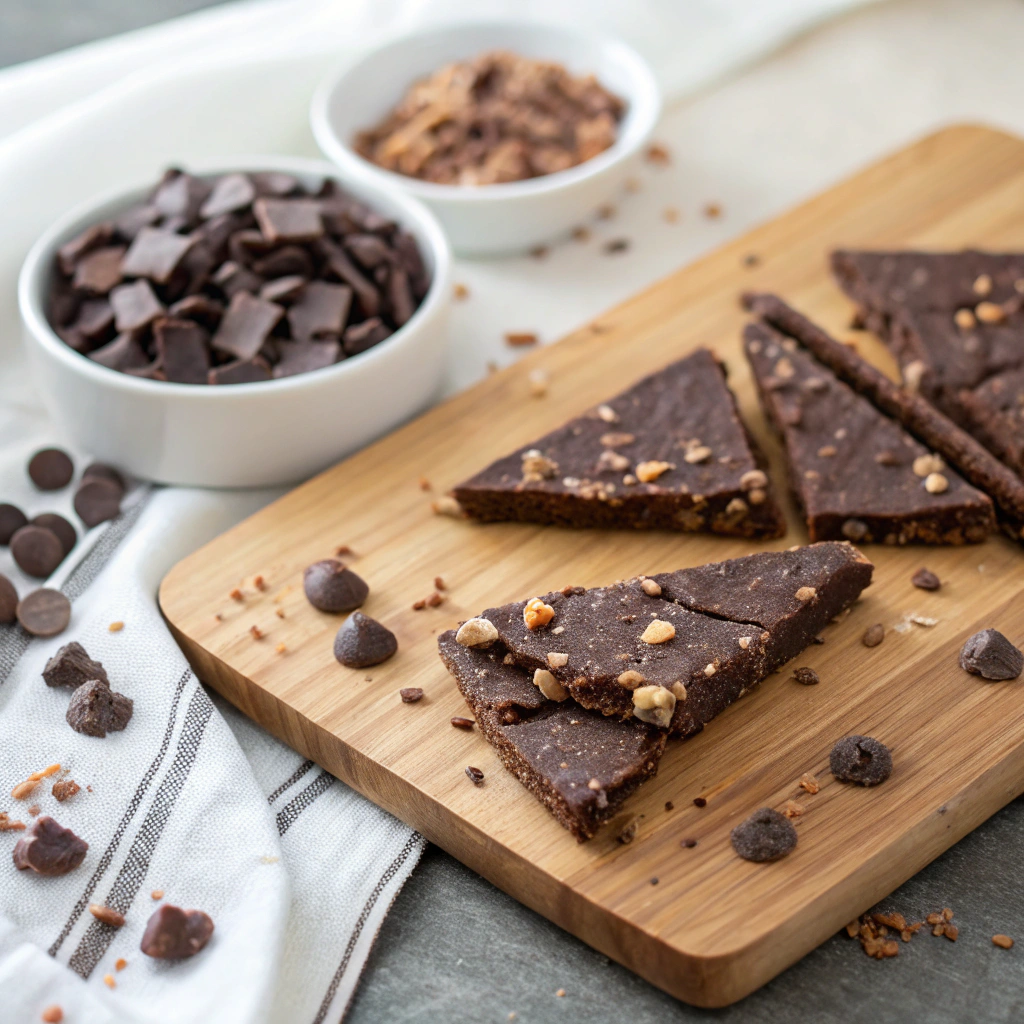Cookie dough bark isn’t just a dessert—it’s a warm memory in every bite. The kind that makes you pause, smile, and maybe even remember someone who used to sneak you raw cookie dough off a wooden spoon.
Hi, I’m Lena Marlowe. I grew up in Savannah, Georgia, in a home where love smelled like biscuits in the oven. My grandmother taught me how to bake with soul, and my mama taught me how a warm meal could heal just about anything. I never went to culinary school—I learned by doing, burning, stirring, and starting over.
During the 2020 lockdown, like many, I was looking for connection. So I started sharing my kitchen experiments online. What began as comfort for me quickly turned into a little corner of the internet where thousands found joy, flavor, and a reminder that food doesn’t have to be perfect—it just has to be made with love.
Now I cook for real life—for busy moms juggling a million things, for brave beginners unsure where to start, and for anyone who finds joy in a worn wooden spoon and a preheated oven. My food is Southern-inspired, seasonal, and soulful. I believe in butter, laughter, and setting the table even if it’s just for one. Because that’s what home feels like.
This cookie dough bark recipe was born out of one of those “let’s see what we’ve got in the pantry” moments. It’s simple. No-bake. Filled with texture and warmth. And like everything I share here at Easy Palates, it’s more about love than perfection.
So come on in. Whether your chocolate melts too fast or your dough crumbles a little too much, you’re right where you’re supposed to be. And trust me—this bark is about to become your new favorite sweet bite of comfort.
Table of Contents
Table of Contents
What is Cookie Dough Bark?
– Understanding the Basics of Cookie Dough Bark
Cookie dough bark is a hybrid dessert that fuses two all-time favorites—edible cookie dough and chocolate bark. It’s everything you love about eating raw cookie dough, minus the risk, wrapped up in a sweet slab of melted chocolate that breaks apart into satisfying chunks. It’s not just a treat—it’s a full-on experience.
This no-bake dessert has surged in popularity thanks to its simplicity, indulgent flavor, and Instagram-worthy appearance. Whether you’re prepping a quick snack for your kids or making gifts for the holidays, this bark is as versatile as it is addictive.
At its core, cookie dough bark consists of:
- A layer of melted chocolate that forms the base and topping.
- A center made of egg-free, heat-treated cookie dough that’s soft, chewy, and totally safe to eat raw.
- Optional sprinkles, nuts, pretzels, or even crushed Oreos for added flair.
It’s quick to prepare, requires no oven time, and stores well for days—making it ideal for busy moms, last-minute hosts, or anyone craving something sweet without a lot of effort.
Discover great ideas like these indulgent Greek Honey Donuts if you’re into bold and simple flavors.
– How It Differs from Traditional Cookie Dough or Chocolate Bark
While traditional cookie dough is made to be baked into cookies, cookie dough bark skips the baking altogether and focuses on making the dough itself safe and enjoyable to eat. The key differences come down to safety, texture, and presentation.
Here’s how they compare:
| Feature | Cookie Dough Bark | Traditional Cookie Dough |
|---|---|---|
| Eggs | Not included (to ensure safety) | Usually included |
| Flour | Heat-treated to kill bacteria | Raw flour, meant for baking |
| Texture | Soft, chewy, firm in chocolate casing | Sticky and soft, melts when raw |
| Purpose | Eaten raw with chocolate bark crunch | Baked into cookies |
| Time to Prepare | Under 20 minutes (no baking) | 30+ minutes with baking and cooling |
Chocolate bark on its own is typically a holiday treat made from layers of chocolate and toppings like peppermint or nuts. Cookie dough bark gives it a fun, nostalgic twist by swapping candy toppings for edible cookie dough.
By combining these two dessert staples, you get the chewy satisfaction of cookie dough and the snap of rich chocolate—all in one bite.
Cookie dough bark isn’t just a dessert. It’s comfort, creativity, and a sweet little escape. Perfect for gifting, for entertaining, or just for sneaking a bite when no one’s looking.
Looking for more comforting desserts? Try our Greek Yogurt Chocolate recipe for another easy, feel-good treat.
Print
Cookie Dough Bark
This cookie dough bark recipe is a rich, no-bake Southern treat made with edible cookie dough layered between smooth, melted chocolate. It’s quick, safe to eat, and totally customizable with fun mix-ins like pretzels, sprinkles, or crushed cookies. Perfect for gifting, sharing, or sneaking straight from the freezer—this is comfort food at its sweetest.
- Total Time: 40 minutes
- Yield: 12 servings / bark pieces
Ingredients
For the Edible Cookie Dough:
½ cup unsalted butter, softened
½ cup light brown sugar, packed
1 tsp vanilla extract
1 cup heat-treated all-purpose flour
¾ cup mini chocolate chips
Pinch of sea salt
For the Chocolate Bark Layers:
2 cups semi-sweet chocolate (bars preferred), chopped
Optional: ½ cup white chocolate, chopped (for swirling)
Optional toppings: crushed pretzels, sprinkles, flaky salt, Oreo crumbs
Instructions
Heat-Treat the Flour:
Spread flour on a baking sheet and bake at 350°F for 5–7 minutes, or microwave in a safe bowl in 30-second intervals until it reaches 165°F. Let cool completely.Make the Edible Cookie Dough:
In a large bowl, cream the softened butter and brown sugar for 2–3 minutes until light and fluffy. Add vanilla extract and cooled flour. Stir to combine. Fold in mini chocolate chips and sea salt. Set aside.Melt the Chocolate:
In a microwave-safe bowl, melt semi-sweet chocolate in 20-second intervals, stirring between each round until smooth. Optional: Melt white chocolate separately for drizzle/swirl effect.Assemble the Bark:
Line an 8×8 baking pan with parchment paper. Pour in half of the melted semi-sweet chocolate and spread evenly. Layer the cookie dough over the chocolate using a spoon or spatula. Pour the remaining melted chocolate on top and smooth out. Swirl in white chocolate and sprinkle toppings if desired.Chill and Serve:
Freeze for 25–30 minutes, or refrigerate until firm. Remove from pan, break into shards, and serve.
Notes
Store in an airtight container in the fridge for up to 7 days, or freeze for up to 2 months.
Let bark sit at room temp for 10–15 minutes before serving for best texture.
This recipe is safe to eat raw—no eggs and heat-treated flour only.
- Prep Time: 10 minutes
- Cook Time: 0 minutes
- Category: Dessert
- Method: No-Bake
- Cuisine: American, Southern-Inspired
- Diet: Vegetarian
Ingredients You’ll Need for the Perfect Cookie Dough Bark
– Pantry-Friendly Essentials
What makes cookie dough bark so appealing is how simple and pantry-friendly it is. You don’t need fancy tools or rare ingredients. Most of these are probably already sitting in your kitchen, waiting to be transformed into magic.
Here’s a breakdown of what you’ll need:
| Ingredient | Purpose | Notes |
|---|---|---|
| Unsalted Butter | Adds richness and structure | Room temp for easy mixing |
| Brown Sugar | Deepens flavor, adds chewiness | Light or dark, both work |
| Vanilla Extract | Warms up the flavor profile | Use pure extract for best results |
| Heat-Treated Flour | Makes dough safe to eat | Bake at 350°F for 5 mins or microwave until 165°F |
| Mini Chocolate Chips | Adds texture and chocolate bursts | Regular chips work but minis mix better |
| Sea Salt | Enhances flavor, balances sweetness | Optional, but highly recommended |
| Semi-Sweet or Dark Chocolate | Creates bark layers | Choose good quality for smoother melt |
Why Heat-Treated Flour?
Regular flour can carry bacteria like E. coli. Heating it to 165°F kills any germs and makes it safe for raw consumption. Simply spread it on a baking tray and bake at 350°F for about 5 minutes—or microwave in 30-second bursts, stirring each time until it hits the temp.
Pro Tip: You can even find pre-treated flour in some grocery stores or online if you’re short on time.
Don’t miss our Greek Dessert Recipe for more flour-based no-bake ideas.
– Choosing the Best Chocolate for the Base
The chocolate in cookie dough bark does more than hold things together—it adds richness, snap, and that crave-worthy contrast to the soft dough layer. But not all chocolate is created equal.
Here’s what to look for:
Best Chocolate Types for Bark:
| Type | Texture After Setting | Flavor Profile |
|---|---|---|
| Semi-Sweet Chocolate Bars | Smooth, snappy | Balanced sweetness |
| Dark Chocolate (60–70%) | Firm with clean break | Rich, slightly bitter |
| White Chocolate | Soft and creamy | Sweet and buttery |
Avoid chocolate chips for the outer layer—they’re designed to hold shape and don’t melt smoothly. Go for high-quality chocolate bars and chop them yourself before melting. The difference in the final texture is worth it.
Want to dress it up? Try these optional toppings:
- Crushed graham crackers or pretzels for crunch
- Shredded coconut for a tropical twist
- Sea salt flakes for gourmet flair
- Red and green sprinkles for a festive finish
Pro Tip: For extra pizzazz, melt white chocolate and drizzle it over the top before chilling. It gives the bark a marble swirl that looks pro and tastes even better.
Looking for inspiration? Try our Greek Yogurt Dessert Recipes for more easy-to-make chocolate treats.
Step-by-Step Recipe Instructions

– Making Safe, Edible Cookie Dough
Let’s get one thing straight—cookie dough bark only works if the dough is safe to eat. That means no raw eggs and no untreated flour. But don’t worry—this part is just as easy as it is important.
Here’s how to make your cookie dough the safe (and delicious) way:
1. Heat-Treat the Flour
Why? Because raw flour can carry bacteria like E. coli. You’ve got two options:
- Oven method: Spread 1 cup of flour on a baking sheet and bake at 350°F (175°C) for 5–7 minutes. Stir halfway through.
- Microwave method: Place the flour in a microwave-safe bowl. Heat in 30-second intervals, stirring after each, until it reaches 165°F.
Let the flour cool completely before using it in your dough.
2. Cream the Butter and Sugar
In a mixing bowl, beat 1/2 cup of softened unsalted butter with 1/2 cup of brown sugar until fluffy. This builds the base and adds that soft, cookie-like texture.
3. Add Vanilla and Heat-Treated Flour
Mix in 1 tsp vanilla extract, then slowly add your cooled, heat-treated flour. Stir until well combined.
4. Fold in Mini Chocolate Chips
Add 3/4 cup mini chocolate chips and a pinch of sea salt for contrast. Mix gently so you don’t overwork the dough.
What you’ll get is a soft, scoopable dough that tastes exactly like your childhood—but safe enough to share with everyone (even the little ones).
– Melting and Layering the Chocolate Bark
This is the fun part. Your base is rich, your dough is ready, and it’s time to layer up that bark.
1. Melt the Chocolate
- Use 2 cups of high-quality semi-sweet chocolate (bars preferred over chips).
- Chop and microwave in 20-second intervals, stirring after each, until silky smooth.
Optional: Melt an additional 1/2 cup of white chocolate for a marbled swirl.
2. Prepare the Pan
Line an 8×8 baking pan or a small sheet tray with parchment paper. Leave extra hanging over the edges to make lifting the bark easier.
3. Layer It
- Pour half of the melted chocolate into the bottom of the pan. Spread evenly with a spatula.
- Drop spoonfuls of cookie dough on top of the chocolate and gently flatten.
- Pour the remaining chocolate over the top and smooth it out.
Add toppings now if using—crushed pretzels, sprinkles, flaked salt, or more mini chips.
4. Chill and Break
Place the pan in the freezer for 25–30 minutes, or until the chocolate is firm. Then lift it out and break into uneven shards with your hands or a knife.
That’s it—your cookie dough bark is ready. It’s sweet, chewy, and has that perfect chocolate snap that makes people think you spent hours in the kitchen (spoiler: you didn’t).
Check out this rich and easy Greek Food Desserts recipe for another bite-sized treat packed with flavor.
Flavor Variations to Try

– Classic to Creative: Flavor Add-Ins
One of the best parts about making cookie dough bark is how easily you can make it your own. The base recipe is rich, buttery, and loaded with chocolate—but the flavor possibilities? Endless.
If you’re the kind of cook who likes to experiment (or just clean out the pantry), this is your section.
Here are some crave-worthy twists to try:
| Flavor Variation | How to Do It | Why You’ll Love It |
|---|---|---|
| Peanut Butter Swirl | Add 2 tbsp of creamy peanut butter to the dough | Rich, salty-sweet, Reese’s vibes |
| Oreo Cookie Crumble | Fold in crushed Oreos and top with extra crumbles | Ultimate cookies ‘n cream effect |
| Salted Pretzel Crunch | Mix pretzel bits into the bark and sprinkle on top | Sweet and salty with a killer crunch |
| Espresso Dark Chocolate | Add 1 tsp espresso powder to melted chocolate | Mocha lovers, this one’s for you |
| Coconut Almond Joy | Fold in shredded coconut + chopped almonds | Tropical twist with extra texture |
These swaps don’t just change the taste—they change the texture, the mouthfeel, the entire experience of eating cookie dough bark. Whether you’re serving a crowd or just spicing up your own snack game, mixing in something unexpected always gets people talking.
Pro Tip: Want to avoid overly sweet bark? Use bittersweet chocolate (70% cacao or more) to create a deeper, more sophisticated flavor balance.
– Seasonal and Holiday-Inspired Mixes
Cookie dough bark is a treat for all seasons—and dressing it up to match the moment makes it even more special. Whether you’re making classroom treats, holiday gifts, or themed desserts, these seasonal spins will keep your recipe fresh all year long.
| Season / Holiday | Add-Ins & Toppings | Result |
|---|---|---|
| Christmas | Crushed candy canes, red/green sprinkles | Peppermint cookie dough bark with crunch |
| Halloween | Mini candy eyeballs, orange M&Ms | Spooky and fun for kids |
| Valentine’s Day | Freeze-dried strawberries, white chocolate swirl | Romantic and pink-toned with fruity pop |
| Spring/Easter | Pastel sprinkles, lemon zest in dough | Fresh, light, and seasonally sweet |
| Fourth of July | Red/white/blue candies, star sprinkles | Patriotic and perfect for BBQ dessert bars |
You can also create a birthday cake cookie dough bark by mixing in rainbow sprinkles and a drop of almond extract. It’s like a celebration in every bite.
These ideas also make bark a perfect edible gift. Wrap shards in parchment paper and tie them up with twine for rustic charm, or stack in jars with ribbon for an elegant homemade present.
Discover great ideas like these simple Greek dessert recipes if you love quick twists on classics with creative toppings.
Tips for the Best Texture and Flavor
– How to Prevent Chocolate Bloom or Greasiness
Ever pulled your beautifully chilled cookie dough bark out of the fridge only to find the chocolate looking dull, streaky, or covered in a strange white film? That’s chocolate bloom, and while it’s still safe to eat, it’s definitely not what you want for presentation—or texture.
Here’s how to prevent it:
1. Use Dry, Clean Tools
Water is the enemy of melted chocolate. Even a single drop can cause it to seize and ruin the smooth finish. Always dry your bowls, spatulas, and spoons thoroughly.
2. Avoid Overheating Chocolate
Melt chocolate slowly using 20-second bursts in the microwave, stirring after each round. Chocolate that gets too hot can become gritty or separate.
3. Tempering for Perfection (Optional)
If you’re gifting bark or want that pro-level glossy snap, tempering is the gold standard. This means carefully heating and cooling your chocolate to precise temperatures for a flawless finish. For everyday bark, it’s optional—but for appearance, it makes a difference.
4. Don’t Refrigerate Unless Necessary
Cold can shock the chocolate and cause bloom. Store your finished bark in a cool, dry pantry if serving within 3–4 days. Only refrigerate in hot climates, and always in an airtight container.
– Getting the Right Cookie Dough Consistency
What separates so-so bark from absolutely addictive bark is the texture of your cookie dough. It should be soft, slightly crumbly, and spreadable—never oily, gritty, or rock-hard.
Here’s how to troubleshoot your dough texture:
| Problem | Cause | Fix |
|---|---|---|
| Too Hard or Crumbly | Not enough fat or too much flour | Add 1 tbsp milk or softened butter until soft |
| Too Greasy or Loose | Overmixed or too much butter | Add 1 tbsp heat-treated flour and mix briefly |
| Gritty Texture | Sugar not creamed long enough | Beat butter and sugar together for 2–3 minutes |
| Too Soft After Chilling | Not enough structure | Add more flour or chill longer before layering |
And always remember—don’t overmix. Once your flour is incorporated, gently fold in the chips and stop. Overworking the dough can lead to a gummy texture and oily separation.
Pro Tip: Want to make your cookie dough bark softer and fudgier? Try folding in 1 tablespoon of condensed milk—it adds chew and richness without affecting structure.
Don’t miss our Greek Yogurt Recipes Dessert collection for more textures that melt in your mouth.
Storage & Shelf Life of Cookie Dough Bark

– How to Store It for Maximum Freshness
Cookie dough bark is one of those desserts that doesn’t just taste better over time—it holds up beautifully when stored right. Whether you’re saving it for snack time or making it ahead for gifting, a few simple storage tips will help keep every bite as fresh and delicious as day one.
Short-Term Storage (1–5 Days)
For best texture and flavor:
- Store bark in an airtight container, layered between parchment or wax paper.
- Keep it at room temperature in a cool, dry place away from direct sunlight.
- If your kitchen runs warm, store it in the fridge—but be sure it’s tightly sealed to prevent condensation or flavor transfer.
Refrigerated Storage
If you prefer chilled bark or need to keep it longer:
- Refrigerate in a container lined with parchment.
- Bring to room temperature before serving to allow the cookie dough to soften.
- Expect a firmer chocolate texture straight from the fridge.
Avoid storing it uncovered—open air leads to chocolate bloom and dried-out cookie dough.
– Can It Be Frozen or Made Ahead?
Absolutely. Cookie dough bark is freezer-friendly and ideal for batch-making ahead of holidays, events, or those midnight cravings.
How to Freeze:
- Once bark is fully set, cut or break into pieces.
- Wrap each piece in parchment or wax paper to prevent sticking.
- Place in a freezer-safe zip-top bag or sealed container.
- Label and date—bark stays fresh in the freezer for up to 2 months.
Thawing Tips:
- Let bark thaw at room temperature in its wrapping for about 20 minutes.
- Avoid microwaving—it may cause uneven melting or soggy dough.
Freezing doesn’t compromise taste, and the texture remains just as rich and satisfying if you’ve sealed it properly.
Want to gift it? Bark makes the perfect DIY treat. Wrap it in parchment, tie with twine, or box it in a clear container for a charming and thoughtful presentation.
Check out this batch-friendly recipe for frozen Greek yogurt dessert ideas to stock your freezer with more sweet backups.
Troubleshooting Common Problems
Even the simplest recipes can throw a curveball, and cookie dough bark is no exception. While it’s easy, a few hiccups—like chocolate that won’t set or dough that feels off—can sneak in if you’re not careful. Don’t worry though—these common problems come with quick fixes that bring your bark right back on track.
– What to Do If Your Bark Won’t Set
There’s nothing more frustrating than beautifully layered bark that just… won’t firm up. Whether it’s soft to the touch or melts the second you pick it up, here’s what might be going on—and how to fix it.
Common Causes:
- Under-melted chocolate that didn’t fully temper
- Too much butter or oil from the cookie dough
- Humidity or warm environment interfering with chocolate setting
Fixes:
- Freeze it for 20–30 minutes if it’s still soft after refrigeration.
- Check that your chocolate was fully melted and smoothed before layering.
- If your kitchen runs warm, always opt for chilling the bark during and after assembly.
Pro Tip: Use a small metal baking pan and line with parchment for more even chilling and easier lifting.
– Fixing Grainy or Gritty Cookie Dough
Texture is everything when it comes to cookie dough bark. The dough should be smooth, scoopable, and slightly firm—not sandy or gritty. If yours turns out rough or lumpy, here’s what likely went wrong:
Possible Issues:
- Under-creamed butter and sugar
- Skipping the heat-treatment step on flour, which can alter texture
- Over-mixing the dough
Solutions:
- Cream butter and sugar for a full 2–3 minutes until light and fluffy.
- Always cool your heat-treated flour before mixing it in.
- Stop mixing as soon as the flour is incorporated—this keeps the dough tender and creamy.
If your dough is already gritty, try adding 1–2 tsp of milk and mixing gently to smooth it out.
– Why Is My Cookie Dough Bark Too Hard After Chilling?
This one’s easy to explain: when you refrigerate or freeze bark, the butter in the cookie dough solidifies, making the center firmer than expected.
Here’s how to handle it:
- Let the bark rest at room temperature for 10–15 minutes before serving.
- If it’s too hard, your dough may have had too much flour—adjust next time by reducing 1–2 tablespoons.
- Prefer a softer center? Add a splash of condensed milk or a tablespoon of brown sugar for added moisture before layering.
– Chocolate Layer Separating from Cookie Dough?
If you bite into your bark and the chocolate snaps right off the dough—yep, we’ve all been there.
What Went Wrong:
- Layers were assembled when the chocolate was too hot or too cold
- The cookie dough wasn’t pressed gently into the bottom chocolate layer
Easy Fixes:
- Always cool melted chocolate slightly before adding dough (but don’t let it harden).
- Press the cookie dough down slightly into the base layer to help it “grip.”
- After the top chocolate layer is added, give the pan a gentle shake or tap to settle it evenly.
Troubles happen in every kitchen. But half the fun of making cookie dough bark is learning how to adjust, fix, and still end up with something delicious—even if it’s not picture-perfect. Because at the end of the day, it’s chocolate and cookie dough—what’s not to love?
Looking for inspiration when things don’t go as planned? Try our Greek Donuts with Honey—they’re just as forgiving and twice as sweet.
FAQs About Cookie Dough Bark
People love this treat—but they also have questions. From texture issues to safety concerns, here are the most frequently asked questions about cookie dough bark, answered clearly and simply.
What happens if you beat cookie dough too long?
Overmixing can ruin your bark’s texture. When you beat the butter and sugar too long—or keep mixing after adding flour—you add too much air and activate excess gluten. The result? A dough that’s too soft, gummy, or overly firm once chilled. For best results in cookie dough bark, mix just until combined and no more.
How to keep your cookie dough from spreading?
This is a common issue, especially if you decide to layer your bark warm or at room temperature. To prevent spreading:
- Chill your dough before adding it to the bark layers.
- Use just enough butter—not too much.
- Don’t overmix, and use mini chips instead of regular ones for a better dough-to-chocolate ratio.
This helps your cookie dough bark hold its shape and stay firm.
How is edible cookie dough safe?
Traditional cookie dough isn’t safe because it contains raw eggs and untreated flour. Edible cookie dough, like the one used in this bark, avoids both:
- No eggs are used.
- The flour is heat-treated to kill bacteria (either in the oven or microwave).
These two changes make cookie dough bark completely safe to eat without baking.
Can you tell if cookie dough has gone bad?
Yes, and you’ll know it fast. Spoiled cookie dough often has:
- A sour or musty smell
- A dry, cracked, or slimy texture
- Discoloration or small white spots (a sign of mold or freezer burn)
If your edible cookie dough bark has been sitting out too long or wasn’t stored properly, play it safe and toss it.
How long does it take for cookie dough to spoil?
Unbaked cookie dough can last:
- 5–7 days in the fridge (in an airtight container)
- Up to 2 months in the freezer
When used in bark and layered with chocolate, it’s best eaten within 7–10 days for peak flavor and texture. Be sure to store it well and always chill it if you’re not serving right away.
Why is my cookie dough so hard after chilling?
Cold temperature causes the butter in the dough to firm up, making your cookie dough bark harder than expected. That’s totally normal. Just leave it out at room temperature for 10–15 minutes before eating—it’ll soften right up.
If it’s still too stiff, try reducing the flour slightly next time or mixing in a teaspoon of milk for a softer chew.
Cookie dough bark is a simple dessert, but like anything worth making, a little knowledge goes a long way. With these FAQ answers in your back pocket, you’re ready to create—and troubleshoot—like a pro.
Don’t miss our Greek Dessert Collection for more traditional favorites reimagined with a modern twist.
Final Thoughts – Why Cookie Dough Bark Belongs in Your Recipe Box
Let’s face it—some recipes are just feel-good from the first bite. Cookie dough bark is one of those rare creations that blends nostalgic joy with no-stress simplicity. It’s forgiving. It’s fast. It’s fun to make. And above all, it’s packed with warmth, flavor, and that satisfying texture contrast that keeps you reaching for “just one more piece.”
In a world where everything moves fast and perfect presentation often overshadows taste, cookie dough bark brings things back to what really matters: flavor, comfort, and love.
It’s a dessert you can make with your kids, serve at parties, or package up for sweet little gifts that say, “I thought of you.” And whether you’re scooping dough on your kitchen counter or breaking apart chilled bark on a cozy Sunday afternoon, it’s the kind of moment that feels like home.
And that’s exactly what we’re about here at Easy Palates—recipes that bring people together. Not because they’re perfect, but because they’re made with care, creativity, and that Southern soul.
So next time your sweet tooth calls, don’t overthink it. Just grab a bowl, melt some chocolate, and make a batch of cookie dough bark. Because comfort shouldn’t be complicated—and in this house, dessert always comes with a side of joy.
Looking for more easy, soulful recipes like this one? Try our Greek Yogurt Chocolate for a rich and refreshing twist.

